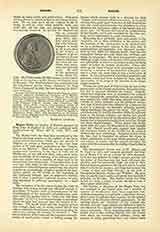

Magdala (Hebr. Migdal = tower, fortress; Aramaic Magdala; Greek Magdala).—It is perhaps the Migdal-El mentioned in the Old Testament (Jos., xix, 38) belonging to the tribe of Nephtali. St. Jerome in his version of Eusebius’s “Chronicle” supposes the place to be in the neighborhood of Dor (Tanturah) on the sea-coast; Kiepert, on the contrary, identifies it with ‘Athlit (Castellum Peregrinorum). The territory of Nephtali, however, never extended so far to the west. According to Matt., xv, 39, after the second multiplication of loaves, Jesus went with His Apostles into the country of Magedan, the name given in various forms (by many of the best authorities, N, B, D, Old Lat., Old Syr., Vulg.). Very many earlier authorities, however, give Magdala instead of Magedan (15 Greek uncials, the Minusculi, 1 Old Lat., Armen., Boh., Seth., Syr., Hex.). The parallel passage in Mark, viii, 10, reads in most recensions Dalmanutha (only D, Syr. Sin. Old Lat. with one exception, Goth., and some Minusculi agree with the name in Matthew). A solution is rendered difficult by the fact that the situation is unknown, and the direction cannot be inferred from the Gospel. The most plausible suggestion is that of van Kasteren who thinks Dalmanutha is the modern El-Delhamiye, about four miles south of the southern end of the lake near the Jordan, north of the influx of the Yarmuk. He also thinks that Magedan is represented by Ma’ad, still more to the south (the change of ghimel to ayin offers no difficulty). In sound the transition from Magdala to Magadan is not impossible in palaeography; it is indeed easily intelligible.
The existence of a Galilean Magdala, the birthplace or home of St. Mary Magdalen (i.e. of Magdala), is indicated by Luke, viii, 2; Mark xvi, 9; Matt., xxvii, 56, 61; xxviii, 1, and in the parallel passages, John xx, 1, 18. The Talmud distinguishes between two Magdalas only. One was in the east, on the Yarmuk near Gadara (in the Middle Ages Jadar, now Mukes), thus acquiring the name of Magdala Gadar; as a much frequented watering place it was called Magdala ceba ‘ayya (now El-Hammi, about two hours’ journey from the southern end of the lake to the east, near a railway station, Haifa-Dera’a). According to various passages in the Talmud, there was another Magdala near Tiberias, at a distance from it of about three and three-quarter miles. Only one mile being given in the Palestinian Talmud, several different places have been identified with it; wrongly, however, for according to the parallel passages in the Babylonian Talmud and the context of the passage, the reading must be condemned as an error. This Magdala, perhaps to distinguish it from the place similarly named east of the Jordan, is called Magdala Nunayya, “Magdala of the Fishes”, by which its situation near the lake and plentiful fisheries appear to be indicated. According to the Talmud, Magdala was a wealthy town, and was destroyed by the Romans because of the moral depravity of its inhabitants. Josephus gives an account (Bell. jud., III, x) of the taking of a town in Galilee, which was situated on the lake near Tiberias and which had received its Greek name, Taricheae (the Hebrew name is not given), from its prosperous fisheries. Pliny places the town to the south of the lake, and it has been searched for there. But a due regard for the various references in Josephus, who was often in the town and was present at its capture, leaves no doubt that Taricheae lay to the north of Tiberias and thirty stadia from it (about three and three-quarter miles). The identity of Taricheae with Magdala Nunayya is thus as good as established.
After the destruction of the Temple, Magdala Nunayya became the seat of one of the twenty-four priestly divisions, and several doctors of law sprang from the town. Christian tradition sought there the home of Mary Magdalen. If we are to believe the Melchite patriarch, Euthychius of Alexandria, the brother of St Basil, Peter of Sebaste, knew of a church at Magdala in the second half of the fourth century, which was dedicated to the memory of Mary Magdalen. About the middle of the sixth century, the pilgrim Theodosius reckoned Magdala’s distance from Tiberias in the south and Heptapegon (now ‘Ain Tabgha) in the north at two miles. At all events the reckoning as to the relative distance between the two places is approximately right. At the end of the eighth century St. Willibald went as a pilgrim from Tiberias past Magdala to Capharnaum. In the tenth century the church and house of Mary Magdalen were shown. The Russian abbot Daniel (1106) and the Franciscan Quaresimus (1616) give the place the name of Magdalia. The small, poverty-stricken village, El-Mejdel, has kept the name and situation to this day. It lies about midway between Tabaryya and ‘Ain Tabgha, at the south end of the little fruitful plain of Genesareth, and rests on the declivities of the mountain which projects over the lake. Towards the west the connection with the inner country of Galilee is effected through Wadi Hamam, past Qarn Hattin. In the caverns of Wadi Haman, about half an hour to the west of Magdala, the Galilean robber bands during the time of the first Herod used to find a safe refuge. Later the caves were occupied by hermits, until finally a stronghold was established there by the Arabs. Mejdel, with its few dirty huts and single palm tree, is all that is left of luxurious Magdala. No ruins of any importance have yet been uncovered.
A. MERK

